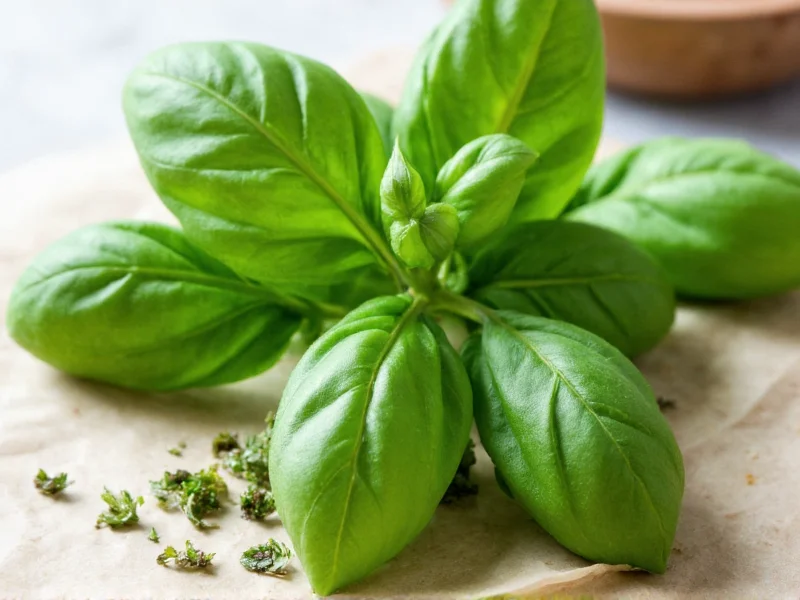Understanding the proper dried to fresh basil ratio ensures your recipes maintain balanced flavor profiles. When substituting dried basil for fresh in recipes, you need less dried herb because the drying process removes moisture while concentrating the essential oils and flavor compounds. This fundamental culinary conversion applies to most dried versus fresh herb substitutions, though basil has specific characteristics worth noting.
Why the 1:3 Dried Basil to Fresh Ratio Works
Basil loses approximately 80-90% of its water content during drying, significantly intensifying its flavor compounds. Fresh basil contains volatile oils that provide its characteristic sweet, slightly peppery flavor with hints of anise. When dried, these oils become more concentrated, making dried basil more potent by volume.
The 1:3 ratio (dried to fresh) has become the culinary standard because it consistently delivers balanced flavor without overpowering dishes. Using equal amounts would result in dried basil dominating the flavor profile, while using too little would leave your dish lacking the distinctive basil notes.
| Dried Basil | Fresh Basil Equivalent | Common Recipe Measurement |
|---|---|---|
| ¼ teaspoon | ¾ teaspoon | Small batch dressings |
| ½ teaspoon | 1½ teaspoons | Sauces and soups |
| 1 teaspoon | 1 tablespoon | Standard recipe conversion |
| 1 tablespoon | 3 tablespoons (¼ cup) | Large batch cooking |
| 2 tablespoons | 6 tablespoons (¼ cup + 2 tbsp) | Preserving or canning |
Factors That Affect Basil Conversion Accuracy
While the 1:3 ratio serves as an excellent starting point, several variables can influence the ideal conversion for your specific cooking situation:
Quality of Dried Basil
Freshly dried basil retains more volatile oils than store-bought dried basil that's been sitting on shelves for months. Commercial dried basil loses potency over time—after 6 months, it may retain only 60-70% of its original flavor. When using older dried basil, you might need to increase the amount slightly beyond the standard ratio.
Culinary Application Matters
The cooking method affects how you should adjust the basil ratio:
- Raw applications (salads, garnishes): Use the full 1:3 ratio since fresh basil's delicate flavor shines
- Long-cooking dishes (stews, braises): Increase dried basil to 1:2.5 ratio as some flavor compounds break down during extended cooking
- Oil-based preparations (pesto, dressings): Fresh basil works better, but if substituting dried, use 1:4 ratio as oil extracts more flavor from dried herbs
Practical Substitution Tips for Home Cooks
When converting between dried and fresh basil in your recipes, consider these professional kitchen insights:
Add dried basil early in the cooking process to allow time for rehydration and flavor development. Unlike fresh basil, which you should add near the end of cooking to preserve its delicate flavor, dried basil needs time to soften and release its concentrated oils into the dish.
For the most accurate dried to fresh basil measurement conversion, use a kitchen scale when precision matters. One tablespoon of fresh basil weighs approximately 2-3 grams, while the equivalent dried basil weighs about 0.7-1 gram. This weight-based approach proves more reliable than volume measurements, especially with loosely packed fresh herbs.
Common Mistakes to Avoid
Many home cooks make these errors when substituting dried basil for fresh:
- Using equal amounts - This results in overwhelmingly strong basil flavor
- Adding dried basil at the end of cooking - Without time to rehydrate, it remains powdery and doesn't integrate well
- Not adjusting for recipe type - Using the same ratio for pizza sauce as for a delicate salad dressing
- Ignoring basil variety differences - Sweet basil versus holy basil have different potency levels
When Fresh Basil Works Best
Certain dishes simply don't translate well with dried basil substitutes. Caprese salad, fresh tomato bruschetta, and classic pesto all rely on the bright, grassy notes of fresh basil that dried basil cannot replicate. The drying process alters the chemical composition of basil's essential oils, creating slightly different flavor compounds.
For authentic Italian dishes like pasta al pomodoro or minestrone soup, fresh basil added at the end provides that signature aromatic finish that dried basil can't match. Reserve dried basil for tomato sauces that cook for 30+ minutes, soups, stews, and other long-simmered dishes where its concentrated flavor can properly develop.
Storing Basil Properly for Maximum Flavor
To get the most accurate dried to fresh basil ratio in your cooking, proper storage matters:
- Store dried basil in airtight containers away from light and heat
- Replace dried herbs every 6-12 months for optimal potency
- Keep fresh basil stems in water at room temperature (refrigeration damages its delicate leaves)
- Freeze fresh basil in olive oil for longer storage while preserving flavor
Understanding these storage principles helps maintain consistent flavor intensity, making your dried basil to fresh conversions more reliable over time.











 浙公网安备
33010002000092号
浙公网安备
33010002000092号 浙B2-20120091-4
浙B2-20120091-4